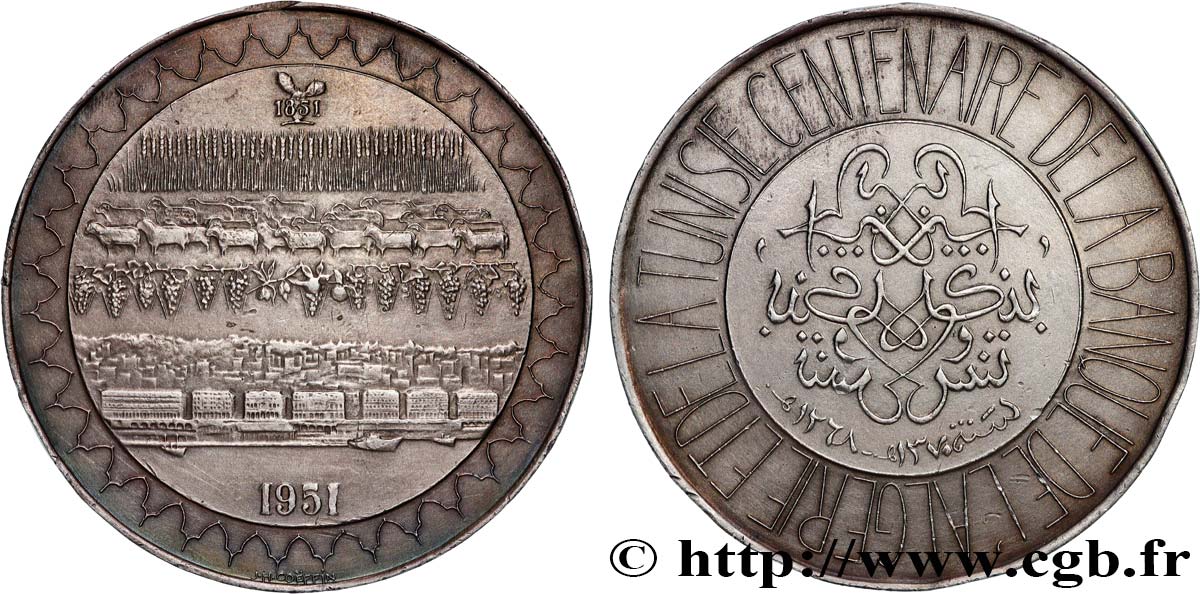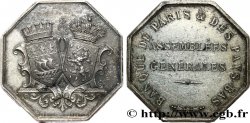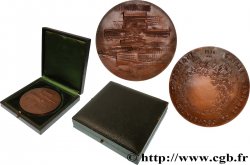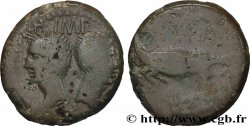fme_857150 - BANQUES - ÉTABLISSEMENTS DE CRÉDIT Médaille, Centenaire de la Banque
220.00 €
Количество
Добавить в корзину

Тип Médaille, Centenaire de la Banque
Дата: 1951
Монетный двор / Город: Tunisie
Металл: silver
Проба: 950 ‰
Диаметр: 76,5 mm
Ориентация осей монеты: 12 h.
Гравер COËFFIN Josette Hébert (1906-1973)
Вес: 171,02 g.
Век: lisse + corne 1ARGENT
Пуансон: corne 1ARGENT
Комментарии о состоянии
Médaille ayant été nettoyée, des taches d’oxydation. Présence de plusieurs coups, en particulier sur la tranche
Лицевая сторона
Аверс: легенда: CENTENAIRE DE LA BANQUE DE L’ALGÉRIE ET DE LA TUNISIE.
Аверс: описание: Inscriptions en arabe dans le champ (en souvenir du centenaire de la banque algérienne et tunisienne), au-dessous 1268-1370 (AH). Signé : J. H. COEFFIN.
Обратная сторона
Реверс: легенда: 1851 - 1951.
Реверс: Описание: Dans le champ, alternance d'épis, de moutons, de grappes de raisin, d'immeubles avec la vue du port d’Alger. Signé : J. H. COEFFIN.
Комментарий
Josette Hébert-Coëffin, née le 16 décembre 1906 à Rouen et morte le 3 juin 1973 à Paris, est une sculptrice et graveuse-médailleuse française. Elle est l'élève de Robert Wlérick, Charles Despiau et Maurice Gensoli. Elle suit des études à l'école des beaux-arts de Rouen où elle obtient un premier prix de sculpture et d'architecture en 1922. Elle est la première lauréate de la fondation John-Simon-Guggenheim à New York. Elle crée des modèles pour la manufacture nationale de Sèvres. Elle obtient une médaille d'or à l'Exposition internationale de 1937 ainsi qu'une médaille d'or de la société d'encouragement pour l'industrie.
La Banque de l'Algérie est une institution financière et monétaire fondée en 1851 et démantelée en 1963 dépendant de la Banque de France. Destinée à gérer la politique monétaire et financière en Algérie, alors sous domination française, la banque est créée sous la IIe République, par une loi adoptée le 4 août 1851 par l'Assemblée nationale législative et promulguée le 8 août par Louis-Napoléon Bonaparte, alors président de la République. Il s'agit alors d'une banque d'escompte, de circulation et de dépôt ayant la forme d'une société anonyme au capital de trois millions de francs — représentés par six mille actions de cinq cents francs — et à laquelle est concédé — initialement pour vingt ans — le privilège d'émettre des billets au porteur de 1000, 500, 200, 100 et 50 francs algériens. Ces billets sont remboursables à vue au siège de la banque ou dans l'une de ses succursales. Un décret du 30 mars 1861 porte le capital de la banque à 10 millions de francs, représentés par 20 000 actions de cinq cents francs,10 et son privilège d'émission est reconduit. Après guerre, les trois partis de la résistance, le PCF, le SFIO et le MRP, demandent la nationalisation des grandes banques (loi du 2 décembre 1945), et de la Banque de l’Algérie. Par la loi no 46-1070 du 17 mai 1946, celle-ci est nationalisée puis, par loi no 49-49 du 12 janvier 1949, elle devient la Banque de l'Algérie et de la Tunisie. À la fin du protectorat de la Tunisie, les bureaux tunisiens ferment et la "Banque de l'Algérie et de la Tunisie" redevient Banque de l'Algérie le 1er août 1958. Le personnel sera muté et réparti entre l'Algérie et Paris..
Josette Hébert-Coëffin, born December 16, 1906 in Rouen and died June 3, 1973 in Paris, was a French sculptor and engraver-medalist.. She is a student of Robert Wlérick, Charles Despiau and Maurice Gensoli.. She studied at the Rouen School of Fine Arts where she won first prize in sculpture and architecture in 1922.. She is the first laureate of the John Simon Guggenheim Foundation in New York.. She creates models for the national factory of Sèvres. She won a gold medal at the 1937 International Exhibition and a gold medal from the Society for the Encouragement of Industry..
The Bank of Algeria is a financial and monetary institution founded in 1851 and dismantled in 1963, dependent on the Bank of France.. Intended to manage monetary and financial policy in Algeria, then under French domination, the bank was created under the Second Republic, by a law adopted on August 4, 1851 by the National Legislative Assembly and promulgated on August 8 by Louis-Napoléon Bonaparte, then President of the Republic.. It was then a discount, circulation and deposit bank in the form of a public limited company with a capital of three million francs - represented by six thousand shares of five hundred francs - and to which was granted - initially for twenty years - the privilege of issuing bearer notes of 1000, 500, 200, 100 and 50 Algerian francs.. These notes are redeemable on demand at the bank's headquarters or at one of its branches.. A decree of March 30, 1861 increased the bank's capital to 10 million francs, represented by 20,000 shares of five hundred francs,10 and its issue privilege was renewed.. After the war, the three resistance parties, the PCF, the SFIO and the MRP, demanded the nationalization of the major banks (law of December 2, 1945), and of the Bank of Algeria.. By law no. 46-1070 of May 17, 1946, it was nationalized then, by law no. 49-49 of January 12, 1949, it became the Bank of Algeria and Tunisia. At the end of the Tunisian protectorate, the Tunisian offices closed and the \\\"Bank of Algeria and Tunisia\\\" became the Bank of Algeria again on August 1, 1958.. The staff will be transferred and distributed between Algeria and Paris..
La Banque de l'Algérie est une institution financière et monétaire fondée en 1851 et démantelée en 1963 dépendant de la Banque de France. Destinée à gérer la politique monétaire et financière en Algérie, alors sous domination française, la banque est créée sous la IIe République, par une loi adoptée le 4 août 1851 par l'Assemblée nationale législative et promulguée le 8 août par Louis-Napoléon Bonaparte, alors président de la République. Il s'agit alors d'une banque d'escompte, de circulation et de dépôt ayant la forme d'une société anonyme au capital de trois millions de francs — représentés par six mille actions de cinq cents francs — et à laquelle est concédé — initialement pour vingt ans — le privilège d'émettre des billets au porteur de 1000, 500, 200, 100 et 50 francs algériens. Ces billets sont remboursables à vue au siège de la banque ou dans l'une de ses succursales. Un décret du 30 mars 1861 porte le capital de la banque à 10 millions de francs, représentés par 20 000 actions de cinq cents francs,10 et son privilège d'émission est reconduit. Après guerre, les trois partis de la résistance, le PCF, le SFIO et le MRP, demandent la nationalisation des grandes banques (loi du 2 décembre 1945), et de la Banque de l’Algérie. Par la loi no 46-1070 du 17 mai 1946, celle-ci est nationalisée puis, par loi no 49-49 du 12 janvier 1949, elle devient la Banque de l'Algérie et de la Tunisie. À la fin du protectorat de la Tunisie, les bureaux tunisiens ferment et la "Banque de l'Algérie et de la Tunisie" redevient Banque de l'Algérie le 1er août 1958. Le personnel sera muté et réparti entre l'Algérie et Paris..
Josette Hébert-Coëffin, born December 16, 1906 in Rouen and died June 3, 1973 in Paris, was a French sculptor and engraver-medalist.. She is a student of Robert Wlérick, Charles Despiau and Maurice Gensoli.. She studied at the Rouen School of Fine Arts where she won first prize in sculpture and architecture in 1922.. She is the first laureate of the John Simon Guggenheim Foundation in New York.. She creates models for the national factory of Sèvres. She won a gold medal at the 1937 International Exhibition and a gold medal from the Society for the Encouragement of Industry..
The Bank of Algeria is a financial and monetary institution founded in 1851 and dismantled in 1963, dependent on the Bank of France.. Intended to manage monetary and financial policy in Algeria, then under French domination, the bank was created under the Second Republic, by a law adopted on August 4, 1851 by the National Legislative Assembly and promulgated on August 8 by Louis-Napoléon Bonaparte, then President of the Republic.. It was then a discount, circulation and deposit bank in the form of a public limited company with a capital of three million francs - represented by six thousand shares of five hundred francs - and to which was granted - initially for twenty years - the privilege of issuing bearer notes of 1000, 500, 200, 100 and 50 Algerian francs.. These notes are redeemable on demand at the bank's headquarters or at one of its branches.. A decree of March 30, 1861 increased the bank's capital to 10 million francs, represented by 20,000 shares of five hundred francs,10 and its issue privilege was renewed.. After the war, the three resistance parties, the PCF, the SFIO and the MRP, demanded the nationalization of the major banks (law of December 2, 1945), and of the Bank of Algeria.. By law no. 46-1070 of May 17, 1946, it was nationalized then, by law no. 49-49 of January 12, 1949, it became the Bank of Algeria and Tunisia. At the end of the Tunisian protectorate, the Tunisian offices closed and the \\\"Bank of Algeria and Tunisia\\\" became the Bank of Algeria again on August 1, 1958.. The staff will be transferred and distributed between Algeria and Paris..








 Cообщить об ошибке
Cообщить об ошибке Распечатать страницу
Распечатать страницу Отправить мой выбор
Отправить мой выбор Задать вопрос
Задать вопрос Consign / sell
Consign / sell
 Информация
Информация















